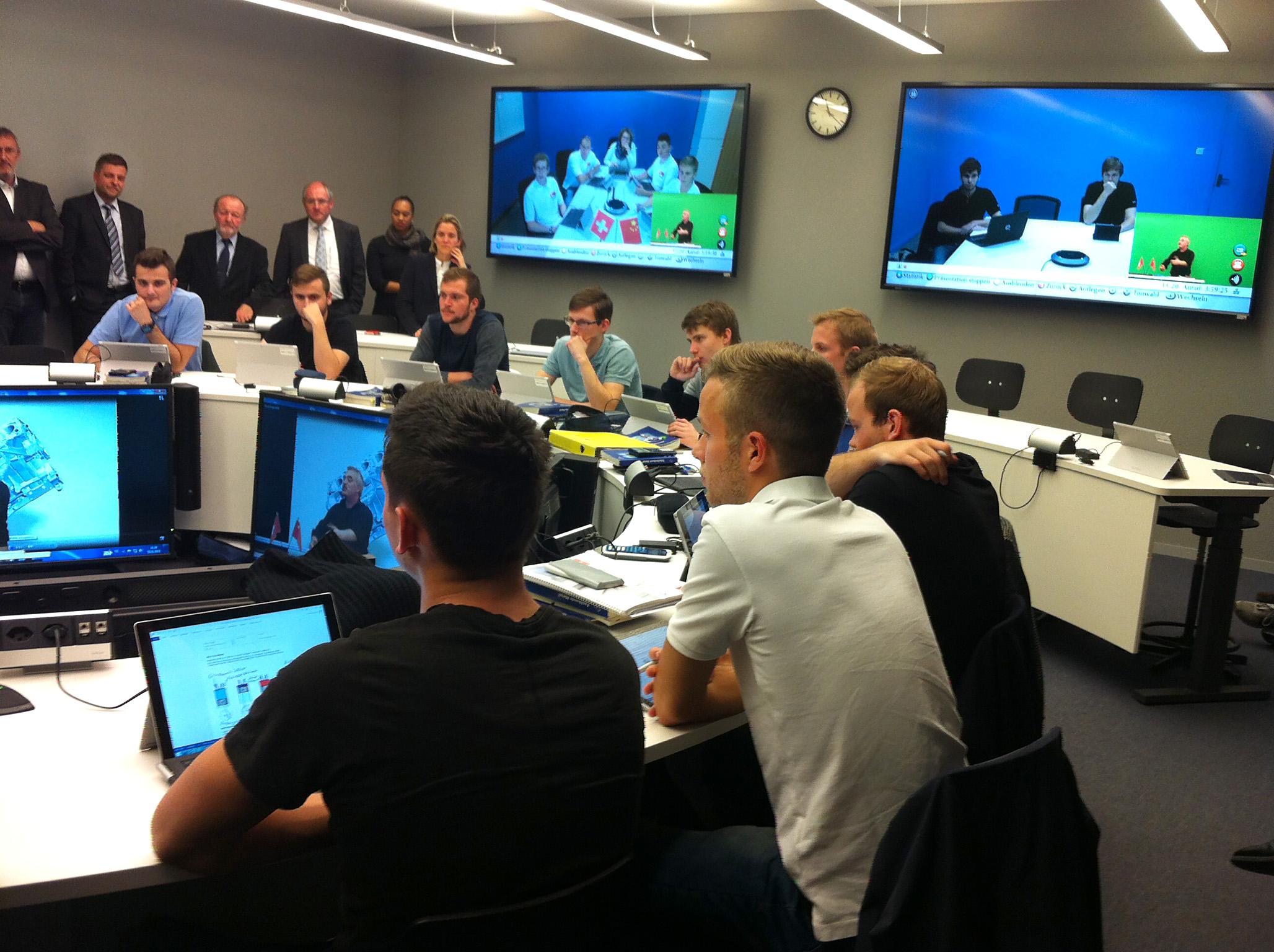
‘Classroom 2.0’ trains Swiss workers from afar

It’s 11am in Switzerland, and 6pm in China. Two groups of students greet each other across 8,000 kilometres, everyone logs into their tablet computers, and class begins. They are among the pioneers learning a trade across distances, with the help of cutting-edge technology.
These groups of apprentices are gathered at the vocational education centre that trains apprentices from Swiss manufacturer Bühler AG, among others. Today, the class is looking at a 3D diagram of a machine, learning to identify its parts.
When Bühler decided it wanted to give its Swiss trainees the chance to work abroad at its other offices, there was one problem: how to allow them to continue with their classroom studies while away from home?
So they launched an experiment by installing a few screens, creating a satellite link and allowing those apprentices who were abroad to connect with their classroom back in Switzerland.
Three years later, those few screens have grown to half a dozen strategically placed around the classroom so the teacher and all students can interact with two other groups simultaneously, joining in from two different locations around the world. In total, Bühler operates 54 so-called telepresence classrooms across the globe in a project called “Classroom 2.0”.
At the flagship classroom in Switzerland, there’s a green screen that allows for demonstrations on 3D models, a touchpad for the teacher to switch between feeds, and an intelligent camera system that focuses on the speaker. The room is warm, thanks to the heat coming off all the equipment.
Why introduce this expensive system just to allow apprentices to go abroad for a few months?
“A few years ago, we stood at a crossroads when it came to apprenticeships,” said Christof Oswald, the head of Human Resources at Bühler, explaining that vocational training was becoming viewed as a less attractive option for students. “We had to change our culture to attract and keep young workers, so it became a strategic factor.”
Sabrina, an apprentice who just returned from three months at Bühler’s location in Minneapolis, says participating in the virtual classroom forced her to concentrate more.
“You have to pay attention because the acoustics weren’t always so great,” she said. “And you know you have to learn the things the teacher is saying, otherwise you’ll be behind. We also had to do more work on our own because we didn’t have a full load of classroom time, so we had to make sure we got the necessary information.”
Company-driven and flexible
Donald Clark believes that companies like Bühler are the future of innovation in vocational training. He’s a UK-based educational technology entrepreneur who believes that apprenticeship offerings – including distance learning – should be driven by companies and their needs, since most already have experience in that area.
“Almost every company in the world uses e-learning or online learning in their training department,” he points out. “It’s already deeply embedded. And when employers pay for apprenticeships, they want it to be super efficient.”
That’s why Clark advocates for reducing the role of colleges and schools in vocational training, instead emphasising training in companies and online. He points to technologies like virtual reality as key tools, which already allow nurses in training to practice treating virtual patients or florists-in-training to put together virtual arrangements, as in the example below.
In general, around the world, Clark sees “the pendulum swinging away from college-based [vocational training] systems” to more fluid ways of teaching that, for example, allow students to begin their studies at any time of the year instead of just at semester breaks.
However, he says that the programmes in countries like Switzerland and Germany, with deeply engrained vocational education systems, still tend to be quite school-based compared to places like the Middle East or China, where “online training is huge” and mostly company-driven.
Christoph Arn, a senior researcher at the Swiss Federal Institute for Vocational Education and Training, says teacher training programmes in Switzerland introduce mobile technology and e-learning possibilities as a matter of standard practice. However, in the area of vocational training, he says there’s not yet a clear picture of what’s happening country-wide.
“It’s hard to have an overall idea of what’s going on in e-learning across Switzerland because we’re missing the data,” he says. “It’s also difficult to regulate it because every career path has its own needs and ways of incorporating e-learning.”
Learning across borders
Nevertheless, the Swiss system – in which 70% of young people learn partially on-the-job instead of at a traditional school – is considered to be one of the world’s most successful. Many high-profile representatives from other countries, such as the US, have paid visits to Swiss companies like Bühler to see how their approach to apprenticeships works in the hopes of promoting similar programmes at home.
But the biggest challenge in replicating the Swiss system is often the classroom part, since it’s difficult for businesses training workers to build partnerships with local schools that can teach them the necessary academic skills. That begs the question: could a programme like Bühler’s provide the missing piece, via distance learning?
Marco Frauchiger, who leads the vocational training centre that helps teach Bühler apprentices and operates the Classroom 2.0 programme, says that “question remains open”. But he and his colleagues are currently working on adding English-language vocational training, perhaps as a first step towards opening their doors – and virtual classrooms – to the world.
“We want to be prepared to educate [apprentices] abroad, and English is key to that,” says Frauchiger. “We want them to be able to do a full international qualification.”
Guaranteeing quality
For now, the stakes are especially high for Classroom 2.0 to succeed because the students involved don’t have any time to waste – they are in their last apprenticeship year and must pass final exams and projects, according to one of their instructors, Carmine Palumbo.
Because Classroom 2.0 is an internal project, the school was able to get it off the ground without needing specific approval from the office that oversees the curricula for federally recognised apprenticeship programmes. For his part, Arn says he’s not aware of any nationwide requirements for e-learning offerings.
“A learning plan has to exist, but schools and businesses are free to decide how they will teach the material,” he says. “But if something didn’t fit in, outside observers would surely react.”
As it turns out, the hardest people to convince were the teachers. Some 80% of the instructors who teach in the Classroom 2.0 programme were against the distance learning concept in the beginning, according to Frauchiger. But he says they came around to the idea through training with a local college of education and working in project teams with their counterparts in the other countries where Bühler operates.
Palumbo thinks e-learning has particular potential in first or second year of vocational training. “I hope that students will already start working this way in secondary school, where we can tell young people to take their phones out and seek answers online.”
Arn agrees that early exposure is key.
“Experience with e-learning technology should start in primary and secondary school, but if that’s not the case, then the apprenticeship certainly needs to offer something [in that area].”

In compliance with the JTI standards
More: SWI swissinfo.ch certified by the Journalism Trust Initiative















![The four-metre-long painting "Sonntag der Bergbauern" [Sunday of the Mountain Farmers, 1923-24/26] had to be removed by a crane from the German Chancellery in Berlin for the exhibition in Bern.](https://www.swissinfo.ch/content/wp-content/uploads/sites/13/2025/12/01_Pressebild_KirchnerxKirchner.jpg?ver=f05a5a9c)















You can find an overview of ongoing debates with our journalists here . Please join us!
If you want to start a conversation about a topic raised in this article or want to report factual errors, email us at english@swissinfo.ch.